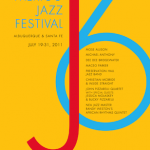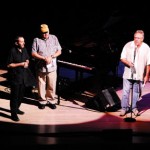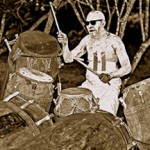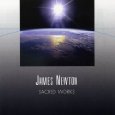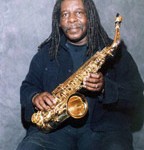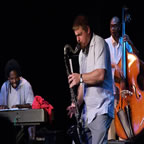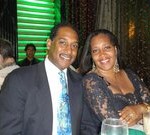Continuing our series of Weeksville Heritage Center interviews with jazz Brooklynites and those musicians and other jazz folk who lived for significant periods in the borough and either created or were a part of Brooklyn’s jazz scene, we turn to the veteran trumpeter-educator Cecil Bridgewater. Mr. Bridgewater, who came to live in the New York area not long after matriculating at the University of Illinois, lived in Brooklyn from roughly 1991-2007. Before that he lived in Queens, however his brother saxophonist Ron Bridgewater moved to Brooklyn in about 1970. Their musical partnership – as a Bridgewater Family band with Cecil’s then-wife, vocalist Dee Dee – took them to several Brooklyn jazz haunts we’ve chronicled in past Independent Ear installments. These included the East, detailed in previous interviews by founding member Jitu Weusi and Mensah Wali, who booked the East.
Past Independent Ear interviews have also included Roger Wareham and Viola Plummer on the development and current scene at Brooklyn’s Sista’s Place. In this conversation Cecil Bridgewater not only provides vivid details in contrasting the remarkable similarities in the scenes at the East and Sista’s Place, he also speaks of playing such other Brooklyn African American-run venues as the Muse, Jazz 966 and touches on our recent subject in this series, the historic Blue Coronet. Do African American jazz musicians get a different feel when playing for largely African American audiences? Read on…
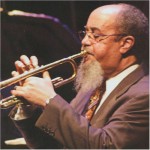
Willard Jenkins: So the time when your brother was living in Brooklyn was during the time of the East. Did you play the East at all?
Cecil Bridgewater: Many times and went there a bunch of times seeing different people – Pharoah Sanders, Betty Carter… you name it, just about anybody that was in there. I remember seeing Gary Bartz there with Andy Bey, but I don’t know if they ever recorded there, [the East] didn’t have the [recording] facilities.
WJ: There were a couple of recordings made there, one that I’m certain of is the record that Mtume made there for Strata East titled “Al-ke-bu-Lan”. Also there is a record called “Pharoah Sanders Live at the East” [Impulse!], but it wasn’t actually recorded at the East. It was during that time and was in the flavor of what Pharoah was doing at the East at the time. What was the scene like playing at the East from a musician’s standpoint?
CB: Very much like playing in your living room as far as the people who came to listen. There was no alcohol so [musicians] weren’t competing for that, you weren’t even competing to get an audience in there because they had a regular following of people who came who were, for lack of a better term, black nationalists or at least that way of thinking and so they really came to enjoy whatever it was that you had to offer. It was a place you could go and just relax and play and you didn’t feel that you were going to be drained, like you were in some of the other places where you’re competing with the alcohol and the food and waitresses running around doing this, that and the other thing. The people just really came to enjoy what you were doing.
WJ: They did have food there…
CB: But you weren’t in competition with that, you were allowed to go ahead and play for whatever length of time you wanted to play it and it was really well accepted. At the same time I was working with Thad Jones-Mel Lewis [Orchestra] at the Vanguard and with Max Roach, and we were doing some touring. Playing in the Village Vanguard, and later at the Blue Note or someplace like that, you realized that you were part of the “help” and you were looked at in that way, like ‘OK, you came in here and you did your job but you did your job just like the bartender or the waitresses; it wasn’t put on that level, but you were just like them.
There was just a different level of respect that you felt when you went into the East. It was like ‘whew’, you could relax and just do what you do, and you always wanted to do it to the highest level. I mean you always want to do that anyway, but you just felt like you knew it was going to be received well [at the East] just because of the nature of the people that were in there.
WJ: What you’re mainly talking about is esthetics, but how did that translate in a musical sense in terms of what you might have played if you had been playing at one of the other clubs in Manhattan, as opposed to what you felt compelled to play at the East?
CB: It could take on a much more Afrocentric perspective. So if we played something… some original tune… my brother had written a thing called “African Sunrise” or we played “Afro Blue” or Dee Dee sang – because it was my brother and I, Dee Dee and a rhythm section, some of the time we used Reggie Workman, Freddie Waits and Stanley Cowell, then later we used Michael Carvin, Hubert Eaves was playing piano with us – we recorded a couple of albums back in the late 1970s. But it was the opportunity of doing things that you would feel maybe – I won’t say uncomfortable [at other clubs] – but you would feel very comfortable doing something [at the East] especially something that had an Afrocentric attitude about it, as opposed to doing that at the Village Vanguard or Sweet Basil.
Sometimes you would do the same things [at other clubs] but you knew they didn’t quite get where it was coming from… A lot of the groups [at the East] were using African percussion that was perfectly accepted there, whereas at some other places it would be like ‘why you got that stuff in there, why you using that(?)’ So when Pharoah or somebody like that would come in [the East] and do something like “The Creator Has a Master Plan,” or even Dee Dee would do some of Aretha Franklin’s stuff with our interpretation of those things, there was no feeling that we couldn’t do that [at the East] or that it wasn’t going to be accepted in a certain kind of way. So it was like whatever you wanted to do would be viewed in a way that that was what you wanted to present and you didn’t have to play some of the “standards”, you could bring in your own material and present it.
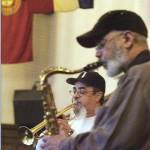
Cecil & Ron Bridgewater in action
I remember hearing Gary [Bartz] and them doing Langston Hughes poem “[I’ve Known] Rivers”, I think it was before he ever recorded it. I said ‘oh, we can do that too’, we can do those kinds of compositions that we put our minds to and it was not going to be questioned or… I don’t want to say ostracized [at other venues], but that was probably what was going on at that time. [At the East] this was an extension of what was going on in the 60s. There was the Collective Black Artists at that time and I got a chance to become a part of that on the back end because they had already done that years before, but to be able to do things that way, to feel like you had some ownership of what you were doing, as opposed to not having ownership. Like the Strata-East record company and all that stuff was active at that time and my brother and I were getting ready to do a recording with them but there was some funny stuff happening at that time.
But all of that stuff that Dr. King and Malcolm X and the Black Muslims had talked about, about owning your own stuff – and Max was talking about that too, and Randy [Weston] – talking about ‘hey, you do something you own that, take that responsibility and don’t just give it away,’ so there was that opportunity for us to do that at the East, where we could play what we wanted to play, the way we wanted to play it and there were no restrictions on us and we didn’t feel like somebody was hovering over us and saying ‘play 60 minutes and get off the bandstand because we’ve gotta sell drinks, turn the house over, etc., etc.’ There was none of that kind of feeling [at the East].
WJ: Besides the fact that it was a black audience, what was the audience’s response and participation at the East as opposed to other places you were playing at the time?
CB: Well you didn’t feel drained. When you played at these other places, the Village Vanguard or some of those other places, you felt like in a sense people were sucking the juice out of you. You didn’t feel like you were getting things back. It’s like the black church, the preacher says something and the older sister says something in the corner, she agrees and she’s talking back to the preacher. The call & response thing is happening all the time; that was kind of the way it was at the East. So if you played something that moved somebody they let you know immediately. It wasn’t like when we would go to Japan with Max and the whole audience would be so quiet with respect, but you didn’t get that until maybe the end of the piece you would get that with loud applause. But at the East you got that immediately. If you did something that moved somebody in the middle of your solo you’d get that ‘yeah, yeah, great, great, go brother, speak…’ all of that kinda stuff.
Like I say it was so relaxed in that way and such a different kind of feel that you got there than any other places. With Max and with Thad Jones-Mel Lewis we were playing all over the world basically, but [the East] was a place that when you got an opportunity to play there you just kind of relaxed and let the music come out.
WJ: And how did those opportunities to play the East come about?
CB: A lot of it was going in and talking with whoever was booking the place at the time and sometimes they approached me and asked me ‘would you like to bring the group in?’ It was the Bridgewater brothers, with my brother [saxophonist Ron] and Dee Dee; the Bridgewater Family was the way it was billed. So we put a group together and let them know it was available and they started calling us.
Getting into May or June they started having an outdoor festival right there on the corner [the East was located at 10 Claver Place in the heart of the Bedford-Stuyvesant district] and then that turned into the International arts festival. So that was a thing where they’d make a stage, invite us to come and play, and it was always such a joyous kind of thing. It was never a drain, you never felt like when you finished you just couldn’t move, and you always felt energized. That kind of atmosphere created a real conducive atmosphere to play and if you came up with something that was totally different than what you had intended to play, it was still well accepted and you didn’t feel like somebody was writing a criticism of how you just did that and it was gonna be scrutinized in that kind of way.
WJ: During that time that you were playing the East, were there other places that you played in Brooklyn?
CB: We put together a group – Reggie Workman, my brother, Michael Carvin, a couple of different piano players, and we called it Top Shelf and we did play at the Blue Coronet; I think I only played in there once or twice. That was a historic place for me even to walk into, having known a lot of the people that played there, including Max and Miles and all of these different people. We did get a chance to play there… The Muse, which was on Bedford just off of Atlantic – Reggie Workman was running that at the time and before that Bill Barron had it…
WJ: What was the Muse like?
CB: It was an educational center, cultural center in a sense – not unlike the East – but they also were giving lessons to young people that wanted to learn about the music. I remember they put on a thing where they had Krasilovsky, the lawyer that wrote a book about the music business; he came in and gave a lecture, an educational kind of thing for musicians of every age to know about how to protect yourself legally, with your publishing, contracts and all that kind of stuff. So Reggie brought him in. There was also a big band there so guys could go in and learn how to play. It was on Bedford just below Eastern Parkway. That was the early 1970s, they started in the late ‘60s but around ’72 I think Reggie came in and was the head of the program there.
WJ: Was there any sense of competition between the East and the Muse?
CB: Not really. If anything, the Muse was the educational center for the musicians whereas the East was like an educational center for grade school students, trying to give them a sense of who they were and what they should be about. On the weekends was when they had the music [at the Muse]. I taught a little bit there, Reggie brought me in to do some big band and do some teaching with some of the trumpet students.
WJ: How old were the students?
CB: They were anywhere from preschool on up through high school in their teens. They might have had adults there at the same time.
WJ: So is it your sense that any of those students at the Muse went on to become professional musicians?
CB: Some of the musicians did; there were some students who were at Jazzmobile who were at the Muse. I don’t remember all of the students, but there was an atmosphere there, like the East, where you could come and study for practically no money, it was a matter of musicians giving something to the younger musicians.
WJ: Were there other places that you played in Brooklyn?
CB: There were a couple of things that were done – they weren’t clubs, they were like concerts that were put on at that time. There’s also 966 on Fulton Street, I’ve played there a few times. That was another of those places, the same kind of experiences. We had elders that would come [to Jazz 966] but they knew about the music and they intimately knew a lot of the musicians that had performed here in Brooklyn. I remember one year it was around my birthday and they were talking about people who had had birthdays that month who were musicians. That was the other thing about the East and the Muse, there were people who were there who were long time jazz fans, who knew intimately some of the musicians who were here in Brooklyn, like the Kenny Dorhams, Freddie Hubbards and all those kind of people who had lived here in Brooklyn at one time or another. Including Randy, all the way back and all the way forward, they knew these people.
[Editor’s note: Jazz 966 is a regular Friday night happening with first class jazz musicians, many of them Brooklyn residents, performing before deeply appreciative audiences in a congenial setting resembling a jazz cabaret party at the Senior Citizen’s facility at 966 Fulton Street.]
WJ: So all these places that you’ve spoken about are all places that had black constituencies and were essentially run by black people. There was uniqueness in that respect as opposed to what was happening in Manhattan. You moved to Brooklyn in ’91. What was happening musically in Brooklyn at the time you moved here?
CB: There were a lot of African American musicians living here and I was living in Fort Green. So there were a lot of us in that area – Eddie Allen, Kenny Davis was down the street from me, Carl Allen lived nearby, Earl McIntyre… a whole bunch of us were in that area. And the other thing is that was quickly accessible to Manhattan so you could get back and forth without any problems. There were maybe not as many clubs going on then and there were lesser known clubs – some places would open up and not be able to stay open for awhile – but there were still some places to play [in Brooklyn].
WJ: What were some of those places?
CB: Well, one was the Brooklyn Conservatory; they were putting on concerts and things there that were going on in the early ‘90s. There was a place on Fulton Street right near BAM… The Up Over was happening on Flatbush; Eddie Allen had the jam sessions on Monday nights that he’d ask me to take over when he couldn’t. Later there was the Night of the Cookers; so there were some places around where you could play or you could go and hear music for a reasonable sum. It wasn’t like you go into the Blue Note and you get gouged; the Blue Note has never made sense to me – you’re playing on one side of the room playing to a wall on the other side! Logistically it makes no sense to me, so it was always kind of uncomfortable for me to play in there. I worked in there with Max mostly, with his quartet and the double quartet. It wasn’t about the music, but then it was; and that’s the difference between that and places like the East and now like Sista’s Place. You go in there and you don’t feel like its all about how much money they can get in, how many seats they’re gonna fill and then turn the house.
The Village Vanguard… I got comfortable in there because I played there so many times with Thad Jones-Mel Lewis and then with Max. Max made a comment one time when we were in there that stayed with me. He said, “This stage is hallowed ground”. I was like ‘really, this is the Vanguard, this is a joint…’ But then he said all the music that’s been made here and all the recordings that have been made here, and then it took on another dimension for me. I talk with my students about this; where you go to perform, that’s where you go to do essentially what you were put on earth to do, and so you’ve gotta respect that, you’ve gotta have a certain respect for that and if you don’t you’re not respecting your elders.
Max always talked about the people whose shoulders we’re standing on. So you’ve gotta respect that and you’ve gotta respect the place where you do that, even if its in your home practicing; you’ve gotta have reverence for that kind of place.
But like with the East, with Sista’s Place and some of the other places here in Brooklyn you always had that kind of feeling. Its like on Randy’s concert [50th anniversary “Uhuru Afrika” concert in November ’10], he said “we’re doing this for the ancestors.” It’s not so much about us, but it’s those ancestors whose shoulders we’re standing on – going all the way back. I had an experience, Winard Harper was doing Max’s “Freedom Now” suite and it was at Lincoln Center and he invited me to come to the rehearsal and kind of assist a little bit, I wasn’t playing at all. He had a young sister from DC and she was doing the singing part. So they did “Driva’ Man” and Winard was hitting the drum, and I said ‘but Abbey [Lincoln] was doing that with the tambourine, so let her do that.’ So she did it and I said ‘now that whack that you give [with the tambourine] is the [slave master] whip coming across your back,’ then it began to have a whole different meaning.
Then she did the “Tryptich” and when she got into the “Tryptich” I saw her get caught up, when she was doing the screaming and the hollering and everything [that Abbey Lincoln did on the original recording], she couldn’t come out of it, she didn’t know how to come out of it, and her body just started trembling and she was in tears. Afterwards she sat down and I talked to her and she said ‘I don’t know what happened’. I said ‘I know what happened, the ancestors were coming through, they were using you as a tool to come through.’ And she was like ‘really?’ it was like a whole ‘nother mind set that she took on.
In the performances – they did two nights – she didn’t quite get there, but she approached that. It was at Lincoln Center at the Kay Playhouse at Julliard and it was kind of difficult to get there looking out over a sea of white faces. But if she’d been at the East or someplace, she would have had no problem getting there [laughs], because the ancestors would have helped her and she would have felt them in the crowd. That’s what I mean by sometimes it feels like you’re being drained when you’re not in that environment because essentially you’re playing for people who don’t understand where its coming from or what it’s about.
WJ: That Lincoln Center audience understood the historic importance of the work but not necessarily the root source of the work?
CB: That’s right.
WJ: Talk about Sista’s Place.
CB: It’s very much the same atmosphere that I felt when I went into the East, and I often mention that to the audience and a lot of people were at the East or know about the East and so when they come [to Sista’s Place] they bring that same vibe in there. But that same kind of energy and knowledge of that cultural aspect at Sista’s place has been transplanted from the East by the people that run [Sista’s Place], they understand that, they allow you to do whatever it is that you’re gonna do; they don’t put any restrictions on how you’re gonna perform or the length of your performances. So anytime I go in there I usually end up playing way overtime [laughs], just because I’m enjoying it and we’re all enjoying it and I look at my watch and realize we should have been off an hour ago.
WJ: So when they say the first set starts at 8:30 and the second set starts at 9:30… throw that out the window?
CB: Yeah right, you might actually start at 8:30 but the second set might not start until 11:00, depending on how it goes. But it’s that kind of energy and willingness that people come in with and participate in it… People ask me sometimes ‘what’s your favorite place to play, or what’s your favorite country to play?’ And essentially it’s wherever people are really there to listen, and I’ve had the most fun at the East and at Sista’s Place, because I don’t feel burdened by anything, I can just go in there and do what I’ve gotta do and talk to the audience, and when I talk to them they understand what I’m talking about, it’s not a fight.
WJ: What kind of band do you usually bring into Sista’s Place?
CB: Usually a quartet – Kenny Davis on bass, last time I was in there I used Michael Howell on guitar, Donald Baker, Rudy Walker comes in on drums, before that sometimes George Gray or Alvin Atkinson will be the drummer… Kenny has been pretty much the constant in the group. When we first went in there we were just playing trio, just trumpet, bass and drums. [Vocalist] Charenee Wade has come in a few times to sit in, Vanessa Rubin has come to sit in… It’s an inviting kind of atmosphere.
Two years ago I had my birthday there [October 10], and Eddie Allen came and sat in, Neil Clarke sat in and played with us, Vanessa, Carla Cook, Charenee, and Karen Francis all came by and sang. It was just like ‘come on, it’s a party in here’ and we’re just gonna have some fun. [The audience] comes in and they want to participate, so it makes it enjoyable from that standpoint and you feel like you’re really at home, they just make it feel that way, you don’t feel that you’re under any kind of restrictions or that people might not understand what you’re talking about, musically or verbally…
I remember we were playing Randy’s 80th birthday concert and I was sitting there on the bandstand next to Billy Harper, Benny Powell and TK Blue and I looked over at Randy and I said to myself ‘you know, this is why I came to New York.’ To experience that kind of thing that I couldn’t experience anyplace else; but Randy’s concerts are always like an event, it’s not like a concert it’s like an event. That’s kind of the way I feel going into Sista’s Place, and like I felt before at the East… it’s not just a performance, you’re not going to a club to play – it’s like an event, and it’s an enjoyable event.
That whole cultural aspect in Brooklyn… You could walk down any of the streets where there are restaurants and just about get any kind of food you want to get. Most of the time we don’t think about culture. What we leave to the rest of the world is our culture: which is our food, our clothing, and our literature, all of that kind of stuff. So when we go back and study Africa and Egypt and all those kinds of places, that’s what we’re looking at.
Coming soon to our ongoing series of Weeksville Heritage Center interviews: Bass master and educator REGGIE WORKMAN on the Muse
